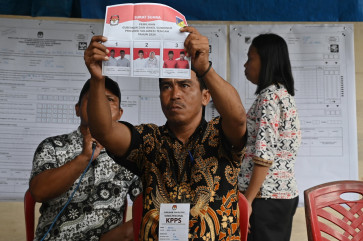Popular Reads
Top Results
Can't find what you're looking for?
View all search resultsPopular Reads
Top Results
Can't find what you're looking for?
View all search resultsUsing fresh approaches to cover common topics
The phrase “there’s nothing new under the sun” might be discouraging for some writers but it is the truth. In a discussion held at Bentara Budaya Jakarta, author Ruhaeni Intan and journalist Mawa Kresna shared their experiences in offering a fresh perspective on a common subject.
Change text size
Gift Premium Articles
to Anyone
The phrase “there’s nothing new under the sun” might be discouraging for some writers but it is the truth.
Many writers struggle to bring out something new from a topic that has been written about countless times by numerous people. As it turns out, the key to this writer’s block lies in how you approach the topic at hand.
In a discussion held at Bentara Budaya Jakarta on May 16, author Ruhaeni Intan and journalist Mawa Kresna shared their experiences in offering a fresh perspective on a common subject.
The discussion is the second event in the run-up to the Jakarta International Literary Festival set to be held by the Jakarta Arts Council in August.
Ruhaeni Intan, 24, is an avid writer, whose works have been published on websites such as mojok.co and tirto.id.
Her debut novel, Arapaima, revolves around a young woman working at a shop selling decorative fish, where the owner of the shop keeps an arapaima fish, a predatory fish native to the Amazon River in South America.
“That particular fish made waves in East Java because an owner let one loose at the Brantas River [in East Java],” she said about the inspiration behind the novel, which was released a few months ago.
“When I heard the news, I didn’t know what the fish looked like, but I finally saw one when visiting a shop in Jakarta,”
As a young writer, Ruhaeni said she had felt the pressure of presenting something fresh and intriguing for her readers.
“I was born in Pati, Central Java, a small town wedged between mountains and the sea. However, I don’t even know enough about my hometown to write about it,” she said.
“I also can’t write about major historical events because of how distanced it is from me. If I wanted to know more about what happened, I would read a history book rather than a novel.”
For those reasons, Ruhaeni decided to write about something she was familiar with. Nonetheless, she dared aspiring writers to explore topics not commonly brought up.
“Indonesia is very huge and there’s a lot more than historical anecdotes. There are the small and not-so-small things we can write about. Why should we write about something that’s been written about numerous times?”
Aquatic: Ruhaeni's debut novel, Arapaima, published several months ago by publishing house Buku Mojok. (Buku Mojok/-)Meanwhile, Yogyakarta-born Mawa Kresna said that in the case of journalism, the problem of finding new things to write about was especially pronounced as they also had to compete with deadlines and other journalists.
Kresna founded beritajogja.id in 2012, after which he worked as a freelance journalist for merdeka.com and Rappler. In 2016, he joined Tirto.id and mainly focused on agrarian issues, diversity and human rights.
The journalist said when someone was struggling with writers’ block when attempting to write about something that’s been done before, the only thing that could save the article was the writing style.
When former Jakarta governor Basuki Tjahaja “Ahok” Purnama was about to be released after serving a prison sentence for blasphemy in January, Kresna understood that he should cover the event from a new perspective.
“Every journalist tried their best to get an exclusive interview with him but none were able to [do that],” Kresna recalled.
Many journalists turned to Ahok’s supporters to write feature pieces on the release.
“Because I don’t work in a fast-paced rhythm like other media outlets, I was at a loss on what to do because the supporters had been interviewed and the articles had been published. From there, I tried to find a way to tell the story about the supporters waiting for Ahok to be released.”
Kresna was reminded of an article in The New York Times titled “How to Tell a Mother Her Child is Dead” by Naomi Rosenberg, in which the article was written in the second person point of view, putting the reader inside the narrative.
“I started to wonder whether we could involve our readers by putting them inside the supporter’s shoes. I asked my editors and they gave me the green light; I met them during the night, slept beside them in front of a [nearby] shop-house and stayed with them until noon.”
Previously, Kresna explored first-person perspective when covering the Surabaya church bombings in May 2018. He compiled accounts from many people into one narrative.
“Methods like these are rarely used by Indonesian journalists. I don’t think it’s because they’re incapable but rather that they simply don’t have the space to do it,” said Kresna, who received an award from the International Labor Organization in 2016 for his piece on domestic workers.
“If they’re given more time to write, I think they can write more than just hard news that resembles features or vice versa.”












